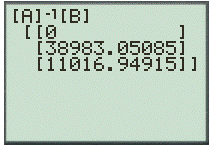
To calculate: The amount invested by him at each rate if he puts at least amount possible in the growth fund.
The amounts for CDs, bonds, and growth funds are $0,
Given Information:
Nicolas has $50,000 to invest and wants to receive $5000 interest the first year. He puts the part in CDs earning 5.75% APY, the part in bonds earning 8.7% APY, and the rest in a growth fund earning 14.6% APY.
Calculation:
Consider the given information,
Suppose that x is representing amount invested at 6% APY, and y is representing amount invested at 8% APY, and z is representing amount invested at 10% APY.
Suppose that x is representing amount invested at
Now, write the equation, as Nicolas invested $50000.
And, he wants a total interest of $5000 in the first years.
It can be observed that he wants 10% of the amount invested and the interest rate in CDs is only
Now, write the system of the matrix as
The equation can be solved as,
Solve for X by multiplying both sides by

The obtained solutions are defined as,
Hence, the amounts for CDs, bonds, and growth funds are $0,
Chapter 7 Solutions
PRECALCULUS:GRAPHICAL,...-NASTA ED.
 Calculus: Early TranscendentalsCalculusISBN:9781285741550Author:James StewartPublisher:Cengage Learning
Calculus: Early TranscendentalsCalculusISBN:9781285741550Author:James StewartPublisher:Cengage Learning Thomas' Calculus (14th Edition)CalculusISBN:9780134438986Author:Joel R. Hass, Christopher E. Heil, Maurice D. WeirPublisher:PEARSON
Thomas' Calculus (14th Edition)CalculusISBN:9780134438986Author:Joel R. Hass, Christopher E. Heil, Maurice D. WeirPublisher:PEARSON Calculus: Early Transcendentals (3rd Edition)CalculusISBN:9780134763644Author:William L. Briggs, Lyle Cochran, Bernard Gillett, Eric SchulzPublisher:PEARSON
Calculus: Early Transcendentals (3rd Edition)CalculusISBN:9780134763644Author:William L. Briggs, Lyle Cochran, Bernard Gillett, Eric SchulzPublisher:PEARSON Calculus: Early TranscendentalsCalculusISBN:9781319050740Author:Jon Rogawski, Colin Adams, Robert FranzosaPublisher:W. H. Freeman
Calculus: Early TranscendentalsCalculusISBN:9781319050740Author:Jon Rogawski, Colin Adams, Robert FranzosaPublisher:W. H. Freeman
 Calculus: Early Transcendental FunctionsCalculusISBN:9781337552516Author:Ron Larson, Bruce H. EdwardsPublisher:Cengage Learning
Calculus: Early Transcendental FunctionsCalculusISBN:9781337552516Author:Ron Larson, Bruce H. EdwardsPublisher:Cengage Learning





